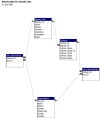Dear Forum,
Apologies if this seems like a trivial question, but I'm a noob and am having a tough time cracking this problem. I have 3 tables: 1 for a table of plant species, 1 for a table of cultivars for each species, and 1 table for organizations that have seeds for either species or cultivars or both. Here is my attempt at relating the 3 tables:
The relationship between species and organizations is many-to-many, the relationship between species and cultivars is one/none-to-many, and the relationship between cultivars and organizations is many-to-many.
Basically, organizations can have seeds for a species and/or its cultivars. That is to say, if an organization has a cultivar's seeds, by biological definition, the organization automatically has seeds for the species; however, if it has seeds for the species, it doesn't necessarily mean it has seeds for a particular cultivar--it could be for a different cultivar or no cultivar (i.e., its just seeds for the plain/original species and not a fancy/altered cultivar).
Is this design appropriate? It seems like it has a circular logic...isn't that a bit of a design faux pas?
Any comments/improvements in this design would be greatly appreciated!

